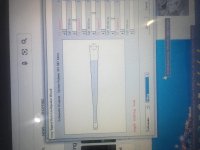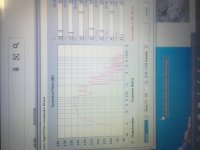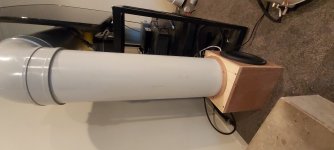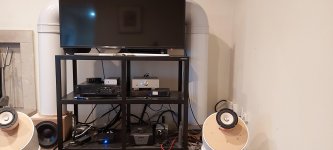So over the weekend I fashioned a shallow cylinder enclosure for the RSS390HO, with a250mm outlet for the Pipeline. With a bit of mussing and fussing around I should be able to get that up and running soon. Will be interesting to check out how it compares with the single RSS265HO which, to my ears, is sounding pretty good compared with anything prior I've used.
I also have a perfect piece of ply just the right size to fashion a box in which I intend to poke both of the RSS265HO-44s, again with the 250mm pipe opening at the top, so we can compare and contrast the two approaches. I just have to find a 2x4 now to replace the flexy fence on my baby table saw.
From the comments I'd guess the two RSS265s will end up being the preferable choice. We shall see.
I also have a perfect piece of ply just the right size to fashion a box in which I intend to poke both of the RSS265HO-44s, again with the 250mm pipe opening at the top, so we can compare and contrast the two approaches. I just have to find a 2x4 now to replace the flexy fence on my baby table saw.
From the comments I'd guess the two RSS265s will end up being the preferable choice. We shall see.
FWIW, at woofer, lower mids WLs, we want sharp/abrupt bends, transitions to reduce unwanted HF pipe resonances modulating the driver and 'reflecting' out the terminus.
GM
This so very true in the construction of length and areas through folding, but then once trying to join two Pipes from opposite sides of the cone to sound atvthe listening positions you suddenly try to depict every single shape very accurately in the line if intentional for a resulting response shape.
Example being what nearly looks like a two stroke cylinder head and exhaust with expansion chamber(s) in my latest ‘endeavor’ from both outputs of the cone or similar but close proximity (‘path’) in HR sim of Nd or Od vs last segment of Tapped horn.
Trying to use air space along the way or instead stuffing to damp not in roll off areas but in the middle of response. Not sure how far to trust the sim roll off, vs the real (at both ends) as the sim shows a perfect scenario and real measured and heard shows different roll off and also different top end response for the void or null shape predicted. Much more in the higher order cabinet it seems then predicted. The upper being less of a void and the lower more of an arc then a flat extended to a sharp turn downward near Fb.
i don’t recall which driver is which or what has changed or how many drivers but its always cool to the simmed responses so you can see after you describe what is heard. I measure and listen vs the sim and besides the room, roll off on either end is not at all as described. A lot of taped pipe stuff is what I’m doing and recently measure, but also TL with the exit and driver very close to each other as simmed.
The shorter than Fs pipe creates a hump in high output response at the bottom. If too long it drops off early and a hooked end happens where the rolled off crashes. Maybe Nice if you have a handful of those all at various lengths to play that all together for every note. But it stands out as strong vs gone if just one... and the overly long version goes nuts at low notes and higher powers.
Now too small but correct in length shows a long arced roll off like a sealed box but worse even. Possible. Too large at the correct length and spikes form on the ends to which I don’t know if but 3 dB seems about fair
The shorter than Fs pipe creates a hump in high output response at the bottom. If too long it drops off early and a hooked end happens where the rolled off crashes. Maybe Nice if you have a handful of those all at various lengths to play that all together for every note. But it stands out as strong vs gone if just one... and the overly long version goes nuts at low notes and higher powers.
Now too small but correct in length shows a long arced roll off like a sealed box but worse even. Possible. Too large at the correct length and spikes form on the ends to which I don’t know if but 3 dB seems about fair
So over the weekend I fashioned a shallow cylinder enclosure for the RSS390HO, with a250mm outlet for the Pipeline. With a bit of mussing and fussing around I should be able to get that up and running soon. Will be interesting to check out how it compares with the single RSS265HO which, to my ears, is sounding pretty good compared with anything prior I've used.
I also have a perfect piece of ply just the right size to fashion a box in which I intend to poke both of the RSS265HO-44s, again with the 250mm pipe opening at the top, so we can compare and contrast the two approaches. I just have to find a 2x4 now to replace the flexy fence on my baby table saw.
From the comments I'd guess the two RSS265s will end up being the preferable choice. We shall see.
Last edited:
i don’t recall which driver is which or what has changed or how many drivers but it ours be cool to provide you with the simmed responses so you can see after you describe what is heard. I measure and listen vs the sim and besides the room, roll off on either end is not at all as described. A lot of taped pipe stuff is what I’m doing and recently measure, but also TL with the exit and driver very close to each other as simmed.
So over the weekend I fashioned a shallow cylinder enclosure for the RSS390HO, with a250mm outlet for the Pipeline. With a bit of mussing and fussing around I should be able to get that up and running soon. Will be interesting to check out how it compares with the single RSS265HO which, to my ears, is sounding pretty good compared with anything prior I've used.
I also have a perfect piece of ply just the right size to fashion a box in which I intend to poke both of the RSS265HO-44s, again with the 250mm pipe opening at the top, so we can compare and contrast the two approaches. I just have to find a 2x4 now to replace the flexy fence on my baby table saw.
From the comments I'd guess the two RSS265s will end up being the preferable choice. We shall see.
I've had a shot at using hornresp to sim my drivers in untapered pipes but man, if you're not used to complex programmes and you're a babe in the woods, so to speak, this is a bit of a monster to get your head around.
If only there was something a bit simpler but a bit more comprehensive than the mh-audio simulator, that would be where I'd head.
And even understanding what some of the experts in the field are saying about TLs is fairly daunting. It is like going to your doctor with a problem and having to ask them to translate into English what they've said you've got in medical jargon and three letter acronyms.
So anyhow I just went ahead and threw the 15-inch RSS390HO into a short cylinder wih a 250cm2 hole in the top and hooked up the Pipeline. Suffice to say, Im not soon going back to a single 10-inch driver. However, I will likely make a box for a pair of them just to compare these with what the single 15 can do, which is make Thunder in the house.
By comparison with the 10-incher, this feels effortless. I've only had it up and running for a bit of TV (finishing the excellent Line of Duty S4) and for a handful of MP3 tunes but it seems punchier. So long as the Pipeline can stay in the house, I'm never going back to sealed or BR cylinders ever again. This, to my mind, is much closer to the real McCoy.
But I would like to be able to optimise it by simming. Will have another look at Brian's software and see if I can get my head around that but hornresp is going to take some serious sit-down I think. And it seems overkill for what Im trying to do, which is a speaker at one end, an untapered pipe with two bends, and an opening at the other.
Pics below. The 'box' for the 15 is a bit rough, but does the trick!
If only there was something a bit simpler but a bit more comprehensive than the mh-audio simulator, that would be where I'd head.
And even understanding what some of the experts in the field are saying about TLs is fairly daunting. It is like going to your doctor with a problem and having to ask them to translate into English what they've said you've got in medical jargon and three letter acronyms.
So anyhow I just went ahead and threw the 15-inch RSS390HO into a short cylinder wih a 250cm2 hole in the top and hooked up the Pipeline. Suffice to say, Im not soon going back to a single 10-inch driver. However, I will likely make a box for a pair of them just to compare these with what the single 15 can do, which is make Thunder in the house.
By comparison with the 10-incher, this feels effortless. I've only had it up and running for a bit of TV (finishing the excellent Line of Duty S4) and for a handful of MP3 tunes but it seems punchier. So long as the Pipeline can stay in the house, I'm never going back to sealed or BR cylinders ever again. This, to my mind, is much closer to the real McCoy.
But I would like to be able to optimise it by simming. Will have another look at Brian's software and see if I can get my head around that but hornresp is going to take some serious sit-down I think. And it seems overkill for what Im trying to do, which is a speaker at one end, an untapered pipe with two bends, and an opening at the other.
Pics below. The 'box' for the 15 is a bit rough, but does the trick!
Attachments
I understand your plight; I've tried for ages to learn advanced antenna design with no luck beyond the most basic radio/TV antennas and those guys are very intolerant to 'newbie' [beginner] questions, ditto prosound forums, so all things considered, we're pretty helpful, easy going as a group. 😀
As for programs, once you move away from basic boxes, it gets complicated to program, though if you use MJK's 'classic TL' design system you can quickly get all the dims to build a good performing speaker or to input into HR to do whatever. It use to be fairly easy, but cramming in all these much more complicated MEH + higher order BP alignments has me feeling like a newbie after decades? of use.
FWIW one can make BR perform as well as a TL since it's really the stuffing that 'makes or breaks' them, but TLs are easier to design/build once the basics are understood. 😉 Where TLs trounce BR is when wanting high efficiency over a narrow BW, i.e. pipe organ type performance.
GM
As for programs, once you move away from basic boxes, it gets complicated to program, though if you use MJK's 'classic TL' design system you can quickly get all the dims to build a good performing speaker or to input into HR to do whatever. It use to be fairly easy, but cramming in all these much more complicated MEH + higher order BP alignments has me feeling like a newbie after decades? of use.
FWIW one can make BR perform as well as a TL since it's really the stuffing that 'makes or breaks' them, but TLs are easier to design/build once the basics are understood. 😉 Where TLs trounce BR is when wanting high efficiency over a narrow BW, i.e. pipe organ type performance.
GM
You might feel like a newbie GM, but I doubt anyone will ever not feel that when diving headfirst into the higher order stuff. I’m kindof of torn between missing the straight forward single dimension persuasion of making the 4th order qw pipes and the fun there vs the exciting but still far from completely ever being able to create with repetition any simmed or not result in 6,8,10th order stuff because pressure/velocity and constructive/destructive interference each take steps along the path that complicate the other in ways to erroneous to nearly any way of describing them to a sim or beyond the sim inputs or the sim has aged out of access for whatever reasons (AKABAKs, LATL don’t really function 100% or will on my laptop).
The best performance I can possibly get at this point is very picky about drivers and needs BL^2/Re in large amounts, possibly 2 12s or 15s being best for the cone area vs issues with rigidity and failure and variations of a FLH merged into bandwidth cleanup via Rez chamber. A hyper paraflex or similar version with greatly expanding path and Rez chamber. But one which places the driver in a pressure area that requires OD (Offset port) SIM in HR, or a throat ported chamber section of TH mode both of which need just one more input adjust ment to allow the missing window of opportunity that’s only otherwise found in lots of saw dust and guessing.
An expanding path of 100-1500cm2 connected to throat chamber and adapter section to keep cone pressure/VAS all happy, while wisely using a Rez chamber and its shape to fill a notch in bandwidth to wisely use the added displacement as contributing to a nice broad and flatfish subwoofer output is as good as I can grab in 350-400+ liters with a specific driver I stick with to keep consistent in my attempts(and it’s cheap). The rss315ho4, however, is in many ways possibly better, the rss265ho4 looks similar on paper too. But I’ve only played with 315...briefly.
I like these pipe designs when the smoke clears of complicated headaches and higher order craziness.. These are neat, fun, kinda unique even nowadays still, and sometimes even cheap. My driver (the 12”) has a Fs of 38, and with a Vas and Qes of 22liters-25, and .33-.35(depends on its mood or the weather/datsv3), it does alright in a smaller CSA sized TL or qw pipe.
That paper Scott wrote kinda makes me stick to big bass reflex or TL shapes, even in little drivers (I play with small hivi or Dayton rs sometimes too) I like the pipes or wooden TL without much CSA change or pushing my luck with reduction or it by much. Not so much chuffing I’ve found, but overstuffed and little to no port output has bitten me once or twice when getting greedy.
The best performance I can possibly get at this point is very picky about drivers and needs BL^2/Re in large amounts, possibly 2 12s or 15s being best for the cone area vs issues with rigidity and failure and variations of a FLH merged into bandwidth cleanup via Rez chamber. A hyper paraflex or similar version with greatly expanding path and Rez chamber. But one which places the driver in a pressure area that requires OD (Offset port) SIM in HR, or a throat ported chamber section of TH mode both of which need just one more input adjust ment to allow the missing window of opportunity that’s only otherwise found in lots of saw dust and guessing.
An expanding path of 100-1500cm2 connected to throat chamber and adapter section to keep cone pressure/VAS all happy, while wisely using a Rez chamber and its shape to fill a notch in bandwidth to wisely use the added displacement as contributing to a nice broad and flatfish subwoofer output is as good as I can grab in 350-400+ liters with a specific driver I stick with to keep consistent in my attempts(and it’s cheap). The rss315ho4, however, is in many ways possibly better, the rss265ho4 looks similar on paper too. But I’ve only played with 315...briefly.
I like these pipe designs when the smoke clears of complicated headaches and higher order craziness.. These are neat, fun, kinda unique even nowadays still, and sometimes even cheap. My driver (the 12”) has a Fs of 38, and with a Vas and Qes of 22liters-25, and .33-.35(depends on its mood or the weather/datsv3), it does alright in a smaller CSA sized TL or qw pipe.
That paper Scott wrote kinda makes me stick to big bass reflex or TL shapes, even in little drivers (I play with small hivi or Dayton rs sometimes too) I like the pipes or wooden TL without much CSA change or pushing my luck with reduction or it by much. Not so much chuffing I’ve found, but overstuffed and little to no port output has bitten me once or twice when getting greedy.
?? Hmm, I'm higher order savvy audio wise, just not WRT simming them in HR.
Yeah, me too with most being floor coupled, tuned empirically via floor gap.
GM
Yeah, me too with most being floor coupled, tuned empirically via floor gap.
GM
?? Hmm, I'm higher order savvy audio wise, just not WRT simming them in HR.
Yeah, me too with most being floor coupled, tuned empirically via floor gap.
GM
Oh, what’s ‘WRT’ stand for?
I keep attempting to emulate a two stroke motors exhaust system and transfer ports with expansion chamber and a Rez chamber. It seems to work but I might be chasing the idea in excess of the software or just finding areas of ‘luck’ with numbers that happen to spit out a sort of flat with lots of output response and assuming it should be pursued...?
Here’s an example That’s not so aggressively positioned or shaped, but similar.
This layout with a few tweaks suits the rss315 and 265ho4 as well (luigi). But I’ve not used it in those (yet).
Attachments
Lightly stuffed here. If I move the driver position or make a throat chamber I get a bit more action, but also, moving the sim so it’s not a rear vented chamber in tapped horn has been sort of beneficial in some ways. If the Rez chamber is depicted at the end of the line which all exits right at the driver by folding the shape in the Offset driver/port exit sim with closed ends. (Pics are of taped horn mode version).
Attachments
Oh, what’s ‘WRT’ stand for?
I keep attempting to emulate a two stroke motors exhaust system and transfer ports with expansion chamber and a Rez chamber.
'With Regard or Respect To': Search NetLingo!
A mass loaded [vented] compression horn is the basic principle I used to design 2 stroke kart exhausts using a hand adjustable, sliding, spring loaded pipe 'vent' to shorten the exhaust pipe as required. Made for really strong hands now somewhat crippled with arthritis for my 'reward'.
GM
'With Regard or Respect To': Search NetLingo!
A mass loaded [vented] compression horn is the basic principle I used to design 2 stroke kart exhausts using a hand adjustable, sliding, spring loaded pipe 'vent' to shorten the exhaust pipe as required. Made for really strong hands now somewhat crippled with arthritis for my 'reward'.
GM
Holy sh!t ! I played with jet skis briefly as a hobby but after years of gas vapor and dry steam in the US Navy submarine fleet. long, Long before I ever looked at a subwoofer speaker and could even make the connection between them until recently as I pushed the shape of essentially is MMJs ‘golden paraflex’ models, for example, if you watch where that will go as it progresses.
I very much believe if you introduced them to a bit of 2 stroke theory and design combined with your speaker savvy experience you will take them further down the path to performance than they could without you! Or at least faster to the same eventual result if you see were it’s progressing or have talked with him independent of the public group where everything is proven before released and must be. You’re a goldmine my friend!
All I once knew and more is either on the net or in books, so readily available.
FWIW when I started down the 'road' in '64 to learn how to design the Lotus/Ford 'bundle of snakes' exhaust system I learned more about TL/muffler design from this 1954 NACA [later NASA] doc written by some of the 'greats' in audio than anything other than the ~ 8 months of pretty intense trial n' error it generated: https://digital.library.unt.edu/ark:/67531/metadc60567/m2/1/high_res_d/19930092208.pdf
The full version, but harder to read: https://ntrs.nasa.gov/archive/nasa/casi.ntrs.nasa.gov/19930092208.pdf
GM
FWIW when I started down the 'road' in '64 to learn how to design the Lotus/Ford 'bundle of snakes' exhaust system I learned more about TL/muffler design from this 1954 NACA [later NASA] doc written by some of the 'greats' in audio than anything other than the ~ 8 months of pretty intense trial n' error it generated: https://digital.library.unt.edu/ark:/67531/metadc60567/m2/1/high_res_d/19930092208.pdf
The full version, but harder to read: https://ntrs.nasa.gov/archive/nasa/casi.ntrs.nasa.gov/19930092208.pdf
GM
Last edited:
So being a Sunday here, and recalling that several of you hornresp experts had said dual 10s (RSS265ho-44s) would work well in the pipeline I have been playing with, I felt it was time to actually try making a box (!) and hook them in.
Thanks to the wonders of youtube I was able to design an 11x13x11 box that fitted both drivers, and a pipeline insert at the top. I decided to fire up the table saw and clamp the fence at the far end, so for the first time ever I actually got straight line cuts. Used some 18mm ply I had lying around. I put the subs on either side of the box.
Only a blood blister for my efforts. Still have two hands, always a bonus.
Wired up the dual voice coil subs in series and parallel, so they end up a 4ohm load.
So how do the dual 10s sound? Perhaps not quite the impact of the 15 but given the drivers aren't working as hard the bass somehow seems a bit cleaner.
Certainly the drivers aren't moving much when hitting the low notes. Only been listening a while so we shall see. No big deal to swap back and forth between the RSS390HO and these.
Thanks again for the advice GM, BS and BW. It's appreciated, the bits I understand at least!
Thanks to the wonders of youtube I was able to design an 11x13x11 box that fitted both drivers, and a pipeline insert at the top. I decided to fire up the table saw and clamp the fence at the far end, so for the first time ever I actually got straight line cuts. Used some 18mm ply I had lying around. I put the subs on either side of the box.
Only a blood blister for my efforts. Still have two hands, always a bonus.
Wired up the dual voice coil subs in series and parallel, so they end up a 4ohm load.
So how do the dual 10s sound? Perhaps not quite the impact of the 15 but given the drivers aren't working as hard the bass somehow seems a bit cleaner.
Certainly the drivers aren't moving much when hitting the low notes. Only been listening a while so we shall see. No big deal to swap back and forth between the RSS390HO and these.
Thanks again for the advice GM, BS and BW. It's appreciated, the bits I understand at least!
Attachments
If you want I can sim them for you and you can see what you hear vs what a sim shows. That way you can decide which way you prefer by what’s heard, but also recognize it as a shape of a response that’s audible or not. Hard to describe but it’ll show the length short or long for various driver arrangements in the unstuffed vs stuffed versions and so on. A room won’t be shown either, so you can possibly see(gear) some of that happening too. It’s kinda weird sometimes when I look after I hear..
All I once knew and more is either on the net or in books, so readily available.
FWIW when I started down the 'road' in '64 to learn how to design the Lotus/Ford 'bundle of snakes' exhaust system I learned more about TL/muffler design from this 1954 NACA [later NASA] doc written by some of the 'greats' in audio than anything other than the ~ 8 months of pretty intense trial n' error it generated: https://digital.library.unt.edu/ark:/67531/metadc60567/m2/1/high_res_d/19930092208.pdf
The full version, but harder to read: https://ntrs.nasa.gov/archive/nasa/casi.ntrs.nasa.gov/19930092208.pdf
GM
Thank you! I have some very interesting reading to do now.
If you want I can sim them for you and you can see what you hear vs what a sim shows. That way you can decide which way you prefer by what’s heard, but also recognize it as a shape of a response that’s audible or not. Hard to describe but it’ll show the length short or long for various driver arrangements in the unstuffed vs stuffed versions and so on. A room won’t be shown either, so you can possibly see(gear) some of that happening too. It’s kinda weird sometimes when I look after I hear..
Yes please. I've tried to get to grips with hornresp multiple times but have had little luck thus far.
The more I listen to this set up with the two 10-inch drivers, the more I like it more than the 15-incher alone. For what it's worth.
The pipeline is 235mm internal diameter, no taper at present, first 2/3 stuffed, and the two drivers are RSS265HO-44.
Specs are:
Nominal Diameter10"
Power Handling (max)1200 Watts
Impedance4+4 ohms
Frequency Response25 to 600 Hz
Sensitivity90.5 dB 2.83V/1m
Voice Coil Diameter2.58"
Resonant Frequency (Fs)27.6 Hz
DC Resistance (Re)1.6 ohms
Voice Coil Inductance (Le)0.77 mH
Mechanical Q (Qms)4.42
Electromagnetic Q (Qes)0.50
Total Q (Qts)0.45
Compliance Equivalent Volume (Vas)1.23 ft.³
Mechanical Compliance of Suspension (Cms)0.21 mm/N
BL Product (BL)9.39 Tm
Diaphragm Mass Inc. Airload (Mms)161g
Maximum Linear Excursion (Xmax)13.25 mm
Surface Area of Cone (Sd)352.3 cm²
Thx for this, much appreciated.
- Home
- Loudspeakers
- Subwoofers
- Quarter wave enclosure for Dayton RSS265HO-44?






